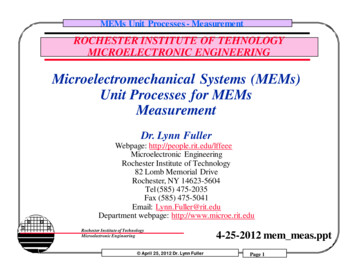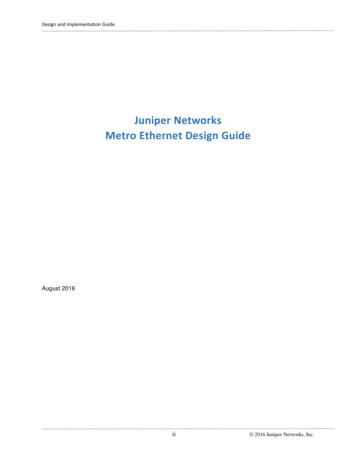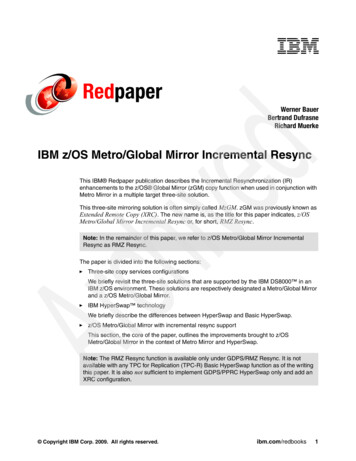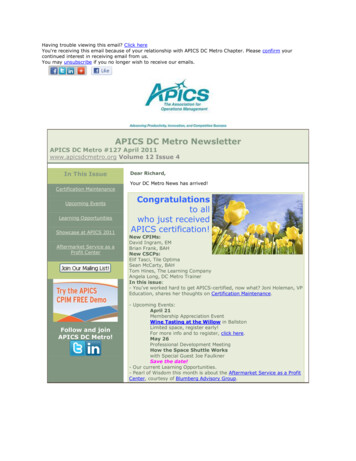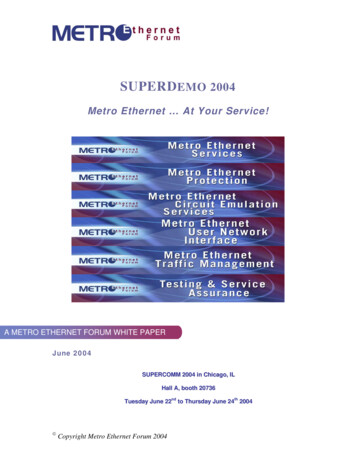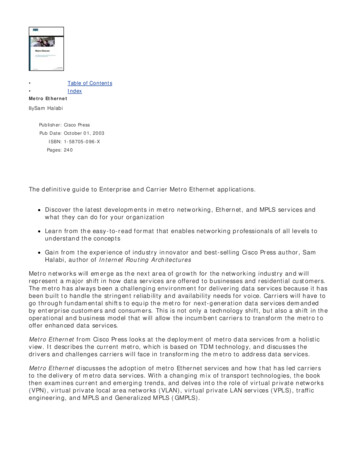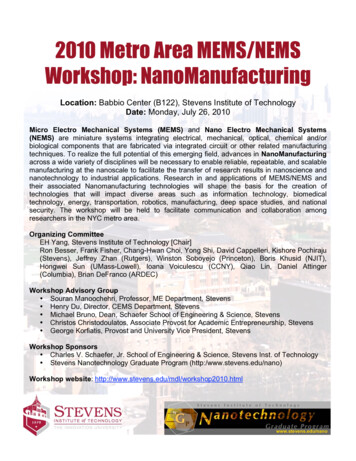
Transcription
2010 Metro Area MEMS/NEMSWorkshop: NanoManufacturingLocation: Babbio Center (B122), Stevens Institute of TechnologyDate: Monday, July 26, 2010Micro Electro Mechanical Systems (MEMS) and Nano Electro Mechanical Systems(NEMS) are miniature systems integrating electrical, mechanical, optical, chemical and/orbiological components that are fabricated via integrated circuit or other related manufacturingtechniques. To realize the full potential of this emerging field, advances in NanoManufacturingacross a wide variety of disciplines will be necessary to enable reliable, repeatable, and scalablemanufacturing at the nanoscale to facilitate the transfer of research results in nanoscience andnanotechnology to industrial applications. Research in and applications of MEMS/NEMS andtheir associated Nanomanufacturing technologies will shape the basis for the creation oftechnologies that will impact diverse areas such as information technology, biomedicaltechnology, energy, transportation, robotics, manufacturing, deep space studies, and nationalsecurity. The workshop will be held to facilitate communication and collaboration amongresearchers in the NYC metro area.Organizing CommitteeEH Yang, Stevens Institute of Technology [Chair]Ron Besser, Frank Fisher, Chang-Hwan Choi, Yong Shi, David Cappelleri, Kishore Pochiraju(Stevens), Jeffrey Zhan (Rutgers), Winston Soboyejo (Princeton), Boris Khusid (NJIT),Hongwei Sun (UMass-Lowell), Ioana Voiculescu (CCNY), Qiao Lin, Daniel Attinger(Columbia), Brian DeFranco (ARDEC)Workshop Advisory Group Souran Manoochehri, Professor, ME Department, Stevens Henry Du, Director, CEMS Department, Stevens Michael Bruno, Dean, Schaefer School of Engineering & Science, Stevens Christos Christodoulatos, Associate Provost for Academic Entrepreneurship, Stevens George Korfiatis, Provost and University Vice President, StevensWorkshop Sponsors Charles V. Schaefer, Jr. School of Engineering & Science, Stevens Inst. of Technology Stevens Nanotechnology Graduate Program (http:/www.stevens.edu/nano)Workshop website: evens.edu/nano
2010 Metro Area MEMS/NEMSWorkshop: NanoManufacturingLocation: Babbio Center (B122), Stevens Institute of TechnologyDate: Monday, July 26, 2010Program Schedule8:00-9:00 amRegistration, Poster Setup, and Poster Session Preview9:00-9:15 amIntroduction, Dr. George Korfiatis, Interim President, Stevens Institute ofTechnology9:15-10:45 amSession I (Chair: Prof. Boris Khusid, NJIT)- A Controllable, Long Shelf Life Micro Battery Architecture Based on Hydrophobic, Lypophobic and MicroFluidic Properties, Victor Lifton, Chief Scientist, mPhase Technologies, Inc.- Low Voltage Actuation of Droplet upon PPy Reduction and Oxidation, Yao-Tsan Tsai (Stevens)- On-Chip Microfluidics for Advanced Functionalization and Operation of Microelectrode Arrays, IsabelBurdallo (NJIT)- AC Electrokinetics in Microfluidics for Lab-on-a-Chip Applications, Sarah Du (Stevens)- Label-Free Characterization of Temperature Dependent Biomolecular Binding by MALDI-TOF MassSpectrometry, Dr. Thai Huu Nguyen (Columbia)- Nanomanufacturing Using Lean Six Sigma Principles, Dhruv Sakalley (Drexel)10:45-11:15amBreak (Posters available for viewing)11:15-12:30 pmSession II (Chair: Prof. Frank Fisher, Stevens)- Wafer-Scale Fabrication of Metallic Nanostructures on Transparent Substrates, Ke Du (Stevens)- Electrodeless Electro-hydrodynamic Printing of Personalized Unit Dosages, Ezinwa Elele (NJIT)- The Nanoaquarium: A Platform For in situ Transmission Electron Microscopy of Processes in Liquid Media,Joseph Grogan (Penn)- Biologically-Inspired Robotic Microswimmers, U Cheang (Drexel)- Towards An Autonomous MEMS Scale Vibration Energy Harvesting Device with Self ResonanceFrequency Tunability, Vinod Challa (Stevens)12:30-1:30 pmLunch1:30-2:00 pmPoster Session, Networking2:00-4:30 pmKeynote Session (Dr. George Hazelrigg, Deputy Director of CMMI, NSF)4:30-4:45 pmClosing Remarks (Dr. Costas Chassapis, Deputy Dean, School of Eng. &Science, Stevens)4:45 pmPoster Session, Networking, Lab Tours Available
!!!Abstracts for oral presentations
!!!
!!!1.1. A CONTROLLABLE, LONG SHELF LIFE MICRO BATTERYARCHITECTURE BASED ON HYDROPHOBIC, LYPOPHOBIC ANDMICRO-FLUIDIC PROPERTIESVictor Lifton, Steve SimonmPhase Technologies, Inc.Contact Information:vlifton@mphasetech.comThis talk will describe how our technical team has developed a novel reserve micro batteryarchitecture based on MEMS processing techniques that mimics one of the observed surfaceinteractions of superhydrophobic properties in structures such as the lotus leaf’s ability to repelwater, and extends the design to also repel very low surface tension organic liquidelectrolytes. This micro/nano structured MEMS silicon surface can be made tunable usingelectrowetting techniques, to design a new class of power storage devices having very long shelflife capabilities.Keywords: MEMS, superhydrophobic, superlyophobic, battery, lithium1.2. LOW VOLTAGE ACTUATION OF DROPLET UPON PPYREDUCTION AND OXIDATIONYao-Tsan Tsai, Ning Gao, Chang-Hwan Choi, Eui-Hyeok Yang,Stevens Institute of Technology!Contact Information: ytsai@stevens.eduConjugated polymers experience a change in their mechanical and electrical properties when“doped” (i.e., undergo reduction and oxidization reactions). The surface state of polypyrrole(PPy) can be switched from hydrophilic to hydrophobic due to re-orientation of its surfactantdopant molecules, dodecylbenzenesulfonate (DBS). A tunable wetting of conjugated polymers isproposed to be used as a novel interlayer material for manipulating droplets at low voltages (0.9V to 0.6V). The shape of an organic fluid droplet can be manipulated on a DBS doped PPyupon electrochemical reactions. On the contrary to the conventional understanding that largecontact angle change enables droplet manipulation due to the Laplace pressure, the movement ofliquid-liquid contact line dominates the droplet deformation. Marangoni effect, i.e. a surfacetension gradient induced upon PPy redox enables a gradient force on the liquid-solid interface isproposed to enable the droplet manipulation, which is envisioned to trigger droplet movement atlow voltage for lab-on-a-chip applications.
!!!1.3. ON-CHIP MICROFLUIDICS FOR ADVANCEDFUNCTIONALIZATION AND OPERATION OF MICROELECTRODEARRAYSIsabel Burdallo1,2, Anil Shrirao1, Antoni Baldi2, Cecilia Jimenez-Jorquera2, Raquel PerezCastillejos11ECE, NJIT2CNM, SpainContact Information: iburba@yahoo.esWe describe the fabrication and use of an on-chip microfluidic structure that providesindividual access to each one of the microelectrodes in an array. The pot ential of having severalsensing elements integrated to a single platform (i.e., array) is oftentimes limited by the inabilityto expose each sensing element to a different set of solutions. The microfluidic system that wepresent here provides individualized control over the liquid environment of each sensingelements in the array. As a demonstrator of the synergy of combining microfluidics and arrays ofintegrated sensors, we describe the use of a microfluidic system for functionalizingindependently each of the two microelectrodes in an array.Keywords: microfluidics, hybrid device, microelectrode, microamperometer1.4. AC ELECTROKINETICS IN MICROFLUIDICS FOR LAB-ON-ACHIP APPLICATIONSSarah E Du, Souran ManoochehriStevens Instiute of TechnologyContact Information: edu@stevens.eduLab-on-a-Chip (LOC) technologies can be utilized in various laboratory operations and haveshown great potential in chemical, biologic al, clinical, and pharmaceutical applications. Ageneral operation platform would benefit LOC technologies significantly, allowing the user tofocus on specific application protocols rather than the design and operation of microfluidicsystems. A concept of AC electrokinetically driven microfluidic platform is proposed to serve asthe most fundamental layer for LOC applications which is capable in essential operationsincluding transport, mixing and separation. The electrokinetic actuation method rivals otheractuation mechanisms such as mechanical systems for its simple fabrication, high degrees ofparallelization and integration, and capabilities of multi-purpose manipulation of microfluids andmicro/nano-particles. A novel design of microgrooved configuration is utilized for ACelectrokinetic transport and pumping of microfluids with different ion concentrations. A hybridmixer consisting of both passive geometrical elements and active electric actuation is developedfor efficient mixing in microchannels. Finally, based the experimental observations andtheoretical analysis of coupling effects of viscous drag and dielectrophoresis on particle motions,a concept of electrohydrodynamic flow mediated dielectrophoretic separator is proposed andevaluated theoretically and numerically.
!!!1.5. LABEL-FREE CHARACTERIZATION OF TEMPERATUREDEPENDENT BIOMOLECULAR BINDING BY MALDI-TOF MASSSPECTROMETRYThai Huu Nguyen, Renjun Pei, Milan Stojanovic, Qiao LinColumbia UniversityContact Information: tn2144@columbia.eduWe present a microfluidic approach to characterizing temperature-dependent biomolecularinteractions. Solvated L-arginine vasopressin (AVP) and its immobilized RNA aptamer(spiegelmer) were allowed to achieve equilibrium binding in a microchip at a series of selectedtemperatures. Unbound AVP were collected and analyzed with matrix-assisted laserdesorption/ionization mass spectrometry (MALDI-MS), yielding melting curves that revealhighly temperature-dependent zones in which affinity binding (36-45 C) or dissociation (2533 C and 50-65 C) occurs. Additionally, temperature-dependent binding isotherms, from whichthermodynamic quantities involved in binding, were extracted. The results illustrated a strongchange in heat capacity of interaction for this system, suggesting a considerable thermodyna micinfluence controlling vasopressin-spiegelmer interaction.!keywords Label-Free, Aptamer, Reversible Binding, MALDI-TOF MS, Microfluidic1.6. NANOMANUFACTURING USING LEAN SIX SIGMA PRINCIPLESDhruv Sakalley, Michael G. Mauk, Vladimir E. Genis, James Hagarman, Yuri GogotsiDrexel UniversityContact Information: dhruv.sakalley@drexel.eduWe are developing experimental designs and protocols to apply Lean Six Sigma StatisticalProcess Control (SPC) and Quality Assurance methodologies to bench-scale processes formaking nanomaterials and nanodevices. Under an NSF-sponsored Course CurriculumLaboratory Improvement (CCLI) grant, nanotechnology experiments have been adapted tosimulate manufacturing processes for which students can apply statistical analysis, ProcessCapability and Value-Added Analysis, Quality Function Deployment (QFD), Design ofExperiments (DOE) and Taguchi methods, Robust Parameter and Tolerance Design, andResponse Surface Methodology. The experiments include synthesis of CdSe quantum dots,template-controlled electrodeposition of magnetic nickel nanowires, organic light-emittingdiodes, and dye-sensitized nanocrystalline TiO2 solar cells. We use digital photography andimage processing to assess materials and device performance, and generate data sets suitable forSix Sigma methodologies. This laboratory-based course will introduce students to the challengesof nano-manufacturing, machine vision and image processing as tools for quality assurance, andSix Sigma approaches to nano-manufacturing. Lean manufacturing principles (e.g., wastereduction, low-volume, high-mix production) are incorporated into the laboratory.
!!!2.1. WAFER-SCALE FABRICATION OF METALLICNANOSTRUCTURES ON TRANSPARENT SUBSTRATESKe Du, Ishan Wathuthanthri, Weidong Mao, Chang-Hwan ChoiStevens Institute of TechnologyContact Information: kdu1@stevens.eduIn this presentation, we will show our recent progress in fabricating wafer-scale metallicnanostructures (Ti and Al) on transparent substrates. High aspect ratio photoresist patterns havebeen fabricated by using interference lithography and the photoresist patterns can be transferredonto metal films with transparent substrates (PDMS and glass) by using soft lithographytechnique. Metal line patterns, pore patterns and dot patterns can all be fabricated by using theproposed technique. Compared with other top-down fabrication techniques, the proposedtechnique has the advantages as low cost and easiness in fabrication steps. Metal nanostructuresfabricated by this technique could be further used in imprinting lithography, surface enhancedRaman Scattering (SERS) and other plasmonic applications.Keywords: Metallic nanostructures, photoresist, interference lithography, soft lithography2.2. ELECTRODELESS ELECTRO-HYDRODYNAMIC PRINTING OFPERSONALIZED UNIT DOSAGESEzinwa Elele, Yueyang Shen, Boris KhusidNew Jersey Institute of TechnologyContact Information: eoe4@njit.eduThe need for small scale manufacturing of personalized treatments have been reinforced bycompelling evidence that substantial variability in drug efficacy in individuals depends on theirgenetic map. Current pharmaceutical technologies are unable to meet this need since mostprocess are typically planned to target large population. A favorable and economical method ofsmall scale manufacturing of tailored therapeutic is found in Drop-on-demand (DOD) printingwhich is widely used in graphic arts printing, electronics, biotechnology and micromachining.However, the diverse physical properties encountered in pharmaceutical formulations poses animpediment to the use of DOD for manufacturing of personalized treatments. The proposedelectro-hydrodynamic DOD printing method overcomes this critical challenge and uses a shortelectrical pulse of an alternating voltage to precisely deposit a customized pendant drop formedat a nozzle exit onto a porous or non por ous edible substrate. The latitude and ease in thedeposition of drops of different physical properties makes it attractive for small scalemanufacturing of personalized treatment and in other applications where precise deposition ofdrops is required.
!!!2.3. THE NANOAQUARIUM: A PLATFORM FOR IN SITUTRANSMISSION ELECTRON MICROSCOPY OF PROCESSES INLIQUID MEDIAJoseph Grogan and Haim H. BauDepartment of Mechanical Engineering and Applied MechanicsUniversity of PennsylvaniaContact Information: jgrogan@seas.upenn.eduTransmission electron microscopes (TEMs) and scanning transmission electron microscopes(STEMs) are among the most powerful nanoscale imaging tools available to the scientificcommunity today, producing detailed images with resolution in the nanometer or even subnanometer range. These high resolution imaging tools, however, cannot readily be used toobserve dynamical processes occurring in liquid media without addressing two experimentalhurdles: sample thickness and sample evaporation in the high vacuum microscope chamber.There are many processes, such as colloidal crystal formation, aggregat ion, nanowire growth,electrochemical deposition, and biological interactions, whose understanding would benefitgreatly from real-time, direct imaging with a TEM/STEM. We have developed a liquid cellTEM/STEM device, dubbed the nanoaquarium, consisting of a hermetically-sealed, 100 nm tall,liquid-filled chamber sandwiched between two freestanding, 50 nm thick silicon nitridemembranes. Embedded electrodes are integrated into the device for sensing and actuation. Ourfabrication approach, based on direct wafer bonding, affords thinner cross-sections than in anypreviously reported devices and thus enables improved contrast and resolution. Additionally, ourfabrication approach allows for high-yield mass production of devices. Direct observation ofdynamical processes in the nanoaquarium, such as diffusion limited aggregation of goldnanoparticles, demonstrate useful preliminary results.
!!!2.4. BIOLOGICALLY-INSPIRED ROBOTIC MICROSWIMMERSU Kei Cheang, Dheeraj Roy, Jun Hee Lee, Min Jun KimMechanical Engineering and Mechanics Department, Drexel UniversityContact Information: ukc23@drexel.eduA biomimetic microswimmer has been fabricated and controlled in a low Reynolds numberfluidic environment. The device utilizes flagellar filaments isolated from Salmonellatyphimurium to mimic the naturally occurring propulsion mechanism of bacteria. Themicroswimmer included a micro-scale polystyrene bead conjugated to a nano-scale magneticbead via a flagellar filament using avidin-biotin linkages. The flagella served two purposes; first,as a fluidic actuator for device propulsion and, second, as a coupler for the polystyrene beadmwhich represents a drug filled vesicle or polymeric encapsulation. The propulsion energy wassupplied by an external rotating magnetic field generated by a set of electromagnetic coilsdesigned in an approximate Helmholtz configuration. In conjunction with a LabVIEW interface,a DAQ controller was used to generate an AC current output from the power supply to theelectromagnetic coils and generate a rotating magnetic field. A high-speed camera provided realtime imaging of the microswimmer motion in a static fluidic environment. Numerical analysiswas performed to develop a simulation of the magnetic control system and the microswimmerunder a simulated magnetic field. The robotic microswimmers exhibited active propulsion intwo-dimensional magnetic fields, which demonstrates the possibility for future biomedicalapplications, such as drug delivery.2.5. TOWARDS AN AUTONOMOUS MEMS SCALE VIBRATIONENERGY HARVESTING DEVICE WITH RESONANCE FREQUENCYTUNABILITYVinod Challa, M. G. Prasad, Frank T. FisherDepartment of Mechanical Engineering, Stevens Institute of TechnologyContact Information: vchalla@stevens.eduVibration energy harvesting seeks to convert kinetic energy existent in mechanical vibrationsto small but useful levels of electrical energy to power wireless sensors and ultra low powerdevices. Increases in power density and wide frequency range operability of these devices arenecessary for the future deployment of this technology. In this regard, MEMS scale devicedevelopment and frequency tunability is being widely pursued as a means to provide efficientpowering of the devices in a manner easily integrated as an on-chip power source for MEMSsensors. In this work, an effort towards the development of a MEMS scale vibration energyharvesting device is presented. Included within the design is resonance frequency tunability,which allows the device to be tuned to various source frequencies in the tunable bandwidth. Heremagnetic force resonance frequency tuning technique is employed to induce the desired amountof additional stiffness; the mode of the magnetic force (attractive, repulsive) would allow thedevice to be tuned to lower and higher source frequencies with respect to the untuned naturalfrequency of the device. Apart from development of a MEMS scale prototype device, ongoingefforts to incorporate autonomous selftunability will be presented.
!!Abstracts for poster sessions!
!!!
!!!HEAT AND PRESSURE ASSISTED ELECTROSTATIC DEPOSITION OFGRAPHENEChristina Alecci, Joseph Katigbak, Johanna Heureaux, and E.H. YangStevens Institute of TechnologyContact Information: calecci@stevens.eduOur research involves anodic bonding-based graphene synthesis. Anodic Bonding is aindustrial process used to chemically bind two surfaces together through intimate contact broughtabout by and intense electric field, heat and pressure. Typically, graphene is made by methodssuch as mechanical exfoliation, but we are optimizing graphene yields per wafer by using theanodic bonding method. We are further developing the anodic bonding process to producegraphene on SiO2 wafers and pyrex by varying the amount of heat, pressure and voltage. Thefabricated samples are scanned using an optical microscope. After all of the graphene pieces arefound, Raman Spectroscopy is used to determine how many graphene flakes are monolayer.Graphene has immense commercial value. Researchers hope to use graphene in replace of siliconmaking flexible electronics, touch screens and sensors.!Keywords: anodic bonding, graphene, raman spectroscopy, exfoliationCHARACTERIZATION OF ENDOTHELIAL CELLS USINGELECTROCHEMICAL IMPEDANCE SPECTROSCOPYS. M. Arifuzzaman1, Fei Liu1, A. N. Nordin2, D. Spray3, I. Voiculescu11City College of New York2Kulliyyah of Engineering IIUM3Kennedy Center Albert Einstein College of MedicineContact Information: sarifuz00@ccny.cuny.eduElectric cell-substrate impedance sensing (ECIS) is a non-destructive electrical approach tomonitor integrity of cell-cell and cell-substrate adhesion in living cells in vitro and in real time.The ECIS approach uses cells that are grown on planar gold electrodes fabricated on the surfaceof culture wells. The electrical impedance between the electrodes is measured and recorded for afrequency range as a function of time. As cells grow on the electrodes the insulating properties ofthe cells can be detected, since the cells contribute with additional resistance to the circuit. Theimpedance incre ases with increasing cell density and reaches equilibrium when the cells areconfluent. The ECIS signal is extremely sensitive to the cell attachment on the electrodes,chemical, biological and physical challenges. Thus, the ECIS signal can be used as a real time invitro bioanalytical measure of the cell behavior. In this paper we report on the electricalimpedance spectroscopy characterization of endothelial cell lines (RFPEC) using commerciallyavailable eight-well cell culture impedance arrays (ECIS-8W1E and 8W10E ). The impedancemeasurements were recorded with cell culture medium (without cells) and with endothelial celllayer in the culture medium over a frequency range from 100 Hz to 64 KHz.
!!!DESIGN AND CONSTRUCTION OF A COMBUSTION SYNTHESISFACILITY FOR NANOPARTICLE GENERATIONThomas Barkley, Jenna Vastano, Smitesh Bakrania,Rowan UniversityContact Information: vastan37@students.rowan.eduThis work involves design and construction of a combustion synthesis f acility with the goalof studying the mechanics of particle formation through combustion as well as producingnanoparticles for use in other studies and applications. At Rowan, a co-flow diffusion burner wasdesigned to support stoichiometric methane – air combustion providing high temperature zonefor synthesis. Tetramethyl tin is used as the liquid precursor to form tin dioxide nanoparticles.The chemical precursor is delivered through a bubbler to the burner using argon as a carrier gas.Particles are deposited via thermophoresis onto a cooling plate for further analysis or for use inother applications. Material characterization on the particles is performed using electronmicroscopy or x-ray diffraction. The current work describes the construction and thecharacterization of the facility. A preliminary investigation on the range of particles the facility iscapable of producing is included. Further studies will involve altering the particle residence timeand combus tion temperature with various flame geometries to achieve better control overparticle morphology and size.Keywords: Combustion Synthesis, Nanoparticles, Tin Dioxide, Flame, Facility DesignSELF-ACTUATING MICROVALVE FOR INTRAOCULAR PRESSURERELIEFDavid Barth, Frank T. Fisher, and E.H. YangStevens Institute of TechnologyContact Information: dbarth@stevens.eduGlaucoma, a major cause of blindness, is treated by lowering the pressure in the anteriorchamber of the eye through drugs, surgery, or implantation of a drainage device. Glaucomadrainage Devices (GDDs) are effective at lowering intraocular pressure even in severe cases ofglaucoma, but have a number of risks and disadvantages including risk of infection, dangerousdrops in pressure, and progressive failure over time due to scar tissue. A design for a selfactuated active one-way microvalve is proposed to provide fine control over aqueous humoroutflow while preventing backflow, which can introduce bacteria into the eye, causing severeinfection. The actuation principle is based on a bimorph cantilever beam made of a polymersubstrate and a hydrogel layer that expands under increased hydrostatic pressure, causing thecantilever to bend. The hydrogel will be a temperature sensitive hydrogel such as PNIPAm, withits lower critical solution temperature (LCST) tuned to be extremely close to the temperature inthe human eye, so small changes in pressure will alter the LCST and cause significant changes inthe volume of the material.
!!!NANOGENERATOR FOR MECHANICAL ENERGY HARVESTINGUSING PZT NANOFIBERSXi Chen1, Shiyou Xu1, Nan Yao2, Yong Shi11Stevens Institute of Technology2Princeton UniversityContact Information: xchen1@stevens.eduEnergy harvesting technologies that are engineered to miniature sizes, while still increasingthe power delivered to wireless electronics, portable devices, stretchable electronics andimplantable bio-sensors are strongly desired. Piezoelectric nano wire and fiber based generatorshave potential uses for powering such devices through a conversion of mechanical energy intoelectrical energy. However, the piezoelectric voltage constant of the semiconductor piezoelectricnanowires in the recently reported piezoelectric nanogenerators are lower than that of PZTnanomaterials. Here we report a piezoelectric nanogenerator based on lead zirconate titanate(PZT) nanofibers. The PZT nanofibers, with a diameter and length of approximately 60 nm and500 !m, were aligned on interdigitated electrodes of platinum fine wires and packaged using asoft polymer on a silicon substrate. The measured output voltage and power under periodic stressapplication to the soft polymer was 1.63V and 0.03 !W, respectively.!Keywords: lead zirconate titanate (PZT), piezoelectric nanogenerator, nano fiber;electrospinning; mechanical energy, bio-MEMSNANOCALORIMETER FOR EVALUATION OF PROTEIN FOLDINGAND LIGAND BXiaoming Chen, Ming Lu, Lei ZuoStony Brook UniversityContact Information: lei.zuo@stonybrook.eduThe objective of the project is to enable comprehensive and rapid evaluation of the proteinfolding and ligand binding at the early stage of drug discovery by developing a new generationof nanocalorimeters array in microplate footprint which reduces the protein consumption from 1ml to 10 !l and decreases the measurement time from hours to minutes. As an initial study, inthis poster we report a fabrication process at BNL clean room and the characterization of asimplified nanocalorimeter using silicon carbide (SiC) as temperature sensing material. DCmagnetron sputtering is used to prepare the SiC film. The deposition conditions and performanceof SiC were investigated. The results show amorphous silicon carbide is a promising material forthis application.!Keywords: Nanocalorimeter, Drug Discovery, Amorphous Silicon Carbide
!!!CAGING MICROMANIPULATION FOR AUTOMATEDMICROASSEMBLY OF MEMS COMPONENTSMichael Fatovic, Utsav Shah, David CappelleriStevens Institute of TechnologyContact Information: mfatovic@stevens.eduAn inverted optical microscope is being used as a testbed fo r automated cagingmicromanipulation to be used for microassembly of MEMS components. The testing apparatusconsists of an inverted optical microscope, and four micromanipulators that have an incrementalstep size of 62.5 nanometers per step. These four micromanipulators will be used to control anobject whose size is in the micro scale. The object will be surrounded, or caged, by the fourmicromanipulators which will in turn give full control to the movement of the object to themicromanipulators. Once the object is in full control it can then be moved, and rotated, about acalculated path. This path will be calculated in such a way that the object will move to thedesired location in the most efficient path while avoiding obstacles.!ANTIBODY FUNCTIONALIZED SEGMENTED NANOWIRE FOR CELLSEPARATION AND DIRECT RAMAN DETECTIONNing Gao, Hongjun Wang, Eui-Hyeok YangStevens Institute of TechnologyContact Information: ngao@stevens.eduIn this work, cell separation technique has been explored at first by using antibodyfunctionalized Ni nanowires. An antibody (anti-CD31) against mouse endothelial cells (MS1)was conjugated to the Ni nanowire surface. The measured cytotoxicity was negligible on the CD31 antibody-functionalized nanowires by the tetrazolium salt (MTT) assay. The use offunctionalized nanowires for magnetically separating MS1 cells revealed that the cell separationyield was closely related to cell concentration and the nanowire/cell ratio. Cell separation yieldusing functionalized Ni nanowires was compared with that using commercial magnetic beads.Considering the volume difference of the material used between the beads and nanowires,antibody-functionalized nanowires showed an obvious advantage in cell separation. The study onthe effect of Ni nanowires on MS1 cells for extended culture confirmed that cell mor phologyremained comparable to control cells with a lower proliferation rate. These results demonstratethat antibody-functionalized Ni nanowires provide an effective means to separate target cells. Infurther work, to implement the direct detection of target cells after cell separation, functionalizedsegmented Au-Ni nanowires with SERS hot-spots are used. The part of Ni nanowire will be usedfor magnetic separation. The nanoparticle-nanowire structure with Raman hot-spots will provideSERS signals from target cells.!Keywords: Segmented nanowires, cell separation, surface enhanced Raman scattering, detection
!!!OPTOFLUIDIC MICRORING RESONATOR SENSORSMichael Grad, Chee Wei Wong, Daniel AttingerColumbia UniversityContact Information: mg2705@columbia.eduOptofluidics is an emerging field that combines microfluidics and optics. We present theintegration of nanophotonic waveguiding structures in microchannels for refractive index sensingpurposes. Using deep-UV lithography and plasma etching, microring resonators are fabricatedfrom Silicon (nSi 3.6) on Silicon Dioxide (nSiO2 1.5) with waveguides 2
New Jersey Institute of Technology Contact Information: eoe4@njit.edu The need for small scale manufacturing of personalized treatments have been reinforced by compelling evidence that substantial variability in drug efficacy in individuals depends on their genetic map. Current pharmaceutical technologies are unable to meet this need since most
